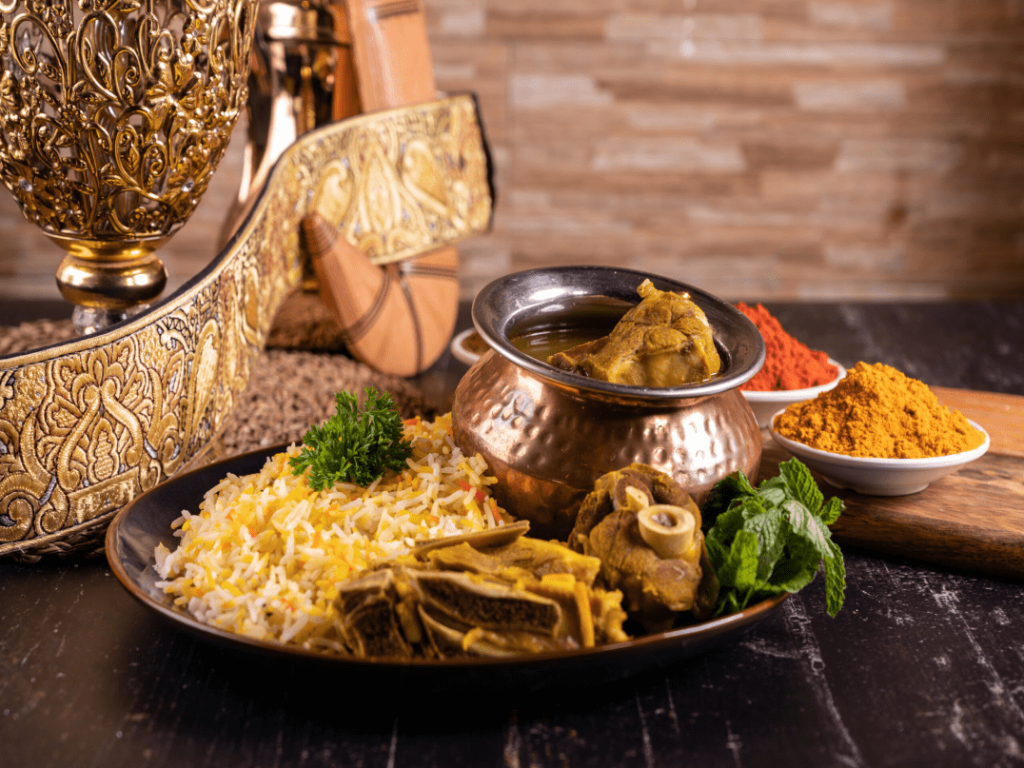Marhaba, fellow food adventurers! Are you ready to embark on a culinary journey that will tantalize your taste buds and deepen your appreciation for Arabic language and culture? Today, we’re setting our sights on Yemen, a land rich in history, hospitality, and incredibly diverse flavors. Get ready to learn some Arabic phrases as we explore the heart of Yemeni cuisine.
A Taste of Yemen: More Than Just Food
In Yemen, food is more than sustenance; it’s an expression of generosity, a cornerstone of social gatherings, and a vital part of the nation’s identity. Unlike many other Arab nations where dinner is the main event, in Yemen, lunch is the grand meal of the day. When you’re a guest, expect a lavish spread – refusing it is considered a deep insult! Meals are often enjoyed communally, with everyone sitting on the floor, sharing dishes, and soaking in the warm hospitality. This emphasis on sharing and connection makes understanding Yemen food culture so enriching for Arabic language learners.
The Main Event: Zurbian vs Mandi
When exploring food in Yemen, two magnificent rice and meat dishes immediately stand out: Zurbian and Mandi. While they may seem similar at first glance, they are distinct culinary experiences. The Zurbian vs Mandi debate is a friendly one among food lovers, with each dish having its own loyal following.
Mandi: The National Treasure
Mandi is arguably the most famous and beloved dish, often considered the national dish of Yemen. It’s a sublime creation featuring incredibly tender meat (usually lamb or chicken) slow-cooked in a tandoor-like oven called a taboon, which imparts a smoky flavor. The meat is served over fragrant Basmati rice, which has been cooked with a delicate blend of spices and sometimes infused with the meat’s drippings. The result is a dish that’s incredibly aromatic, moist, and utterly satisfying.
Zurbian: The Fragrant Cousin
Zurbian, while similar in its use of spiced rice and meat, has a distinct character. It shares roots with Hyderabadi Biryani and often features lamb tenderized in yogurt. What sets Zurbian apart is its rich flavor profile, often achieved through caramelized onions, cardamom pods, cinnamon, and a variety of garam masalas. It’s a dish that boasts a deeper, more intricate spice blend, offering a delightful contrast to the subtle elegance of Mandi.
So, zurbian vs mandi? While both are spectacular rice and meat dishes, Mandi tends to be known for its smoky, succulent meat and subtly spiced rice, whereas Zurbian offers a more complex, aromatic, and richly spiced experience, often with a hint of tang from the yogurt-marinated meat. Trying both is a must to truly appreciate the spectrum of Yemeni cuisine!
The Pillars of Yemeni Plates: What to Expect
Beyond Mandi and Zurbian, Yemen food is built upon a foundation of simple yet flavorful ingredients. Tomatoes, onions, and potatoes are staples, alongside chicken, goat, and lamb. The cuisine makes liberal use of spices like hawaij, a traditional Yemeni spice blend.
Here are some other must-try dishes and culinary insights:
- Basmati Rice: This fragrant grain is the backbone of many Yemeni dishes, including Haneeth (slow-cooked meat with rice), Saltah (a stew often served over rice), and Fahsa (a rich stew served over rice). Its fluffy texture and ability to absorb flavors make it perfect for soaking up the rich broths and sauces.
- Breads: Various types of bread, like Ṣalūf, are essential accompaniments to most meals, perfect for scooping up stews and sauces.
- Shakshouka: A popular breakfast or brunch dish, though often found in various parts of the Middle East, the Yemeni version is rich and flavorful.
- Saltah: Considered by many to be the national dish, Saltah is a hearty stew made from meat, vegetables, and fenugreek froth, served bubbling hot in a stone bowl. It’s often accompanied by a spicy relish called zhug and fresh bread.
- Honey: A highly prized delicacy, Yemeni honey is renowned for its quality and is often enjoyed on its own or as part of desserts.
Learning Arabic Through Food
Immersing yourself in Yemen food culture is an incredible way to pick up Arabic. Imagine sitting down to a meal and asking:
- Is this Mandi? – هل هذا مندي؟ “Hal hatha Mandi?”
- Very delicious! – لذيذ جدًا! “Lathīdh jiddan!”
- Thank you very much! – شكرًا جزيلًا! “Shukran jazīlan!”
- Where can I find authentic Mandi? – أين يمكنني أن أجد المندي الأصلي؟ “Ayna yumkinuni an ajid al-Mandi al-asli?”
Unlock More Arabic with Kaleela!
Ready to go beyond food phrases and truly master the Arabic language? Kaleela is your perfect companion! Our app offers comprehensive lessons, interactive exercises, and native speaker audio to help you speak, read, and understand Arabic with confidence. From basic greetings to complex conversations, Kaleela makes learning Arabic engaging and accessible.
So, while your taste buds enjoy the flavors of Yemen, let Kaleela help your mind savor the beauty of the Arabic language. Download Kaleela App today and continue your journey!



